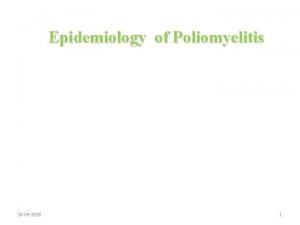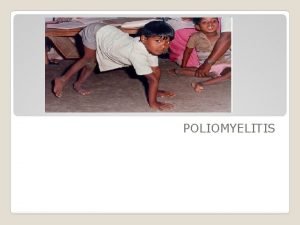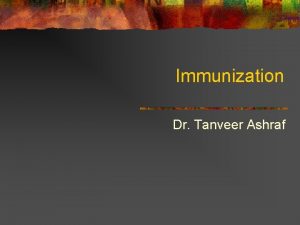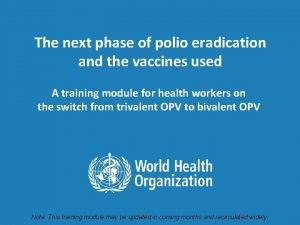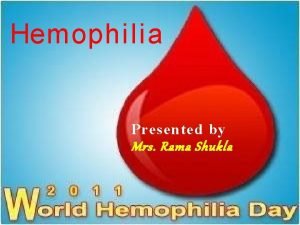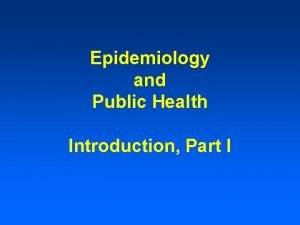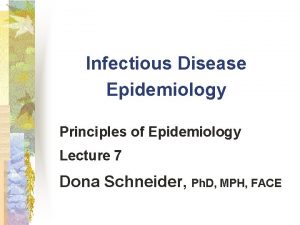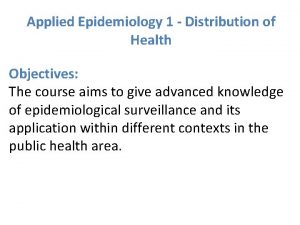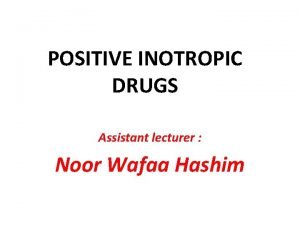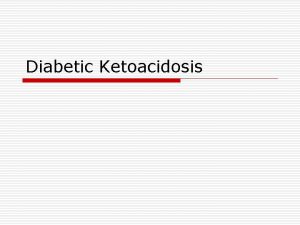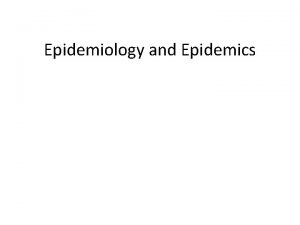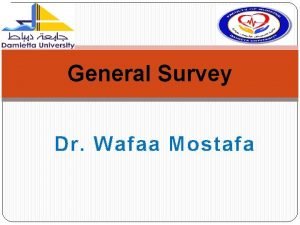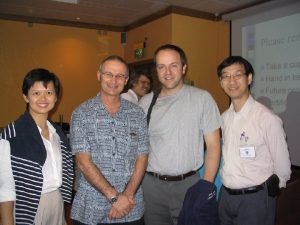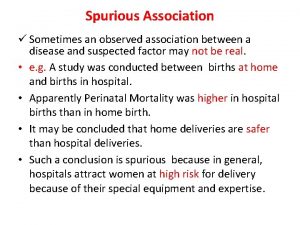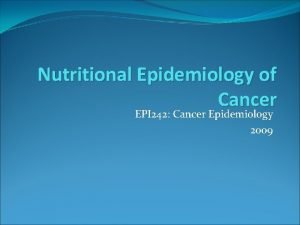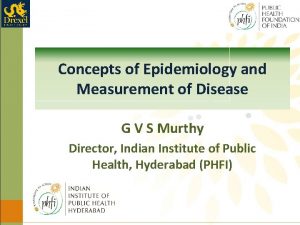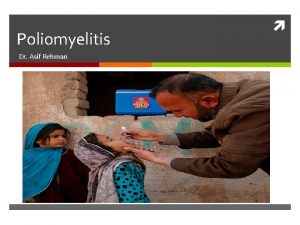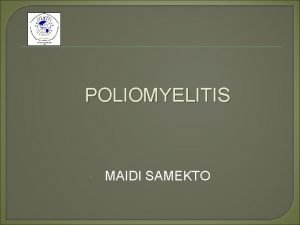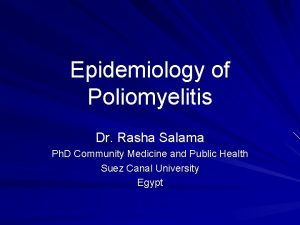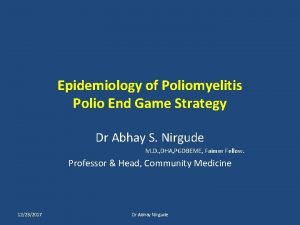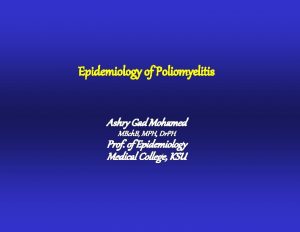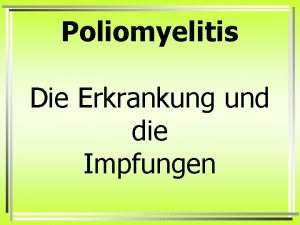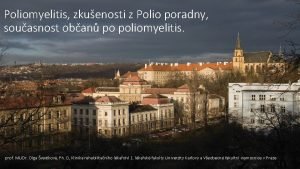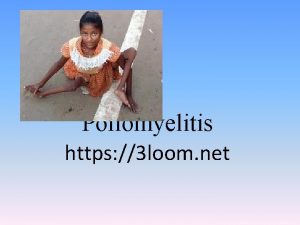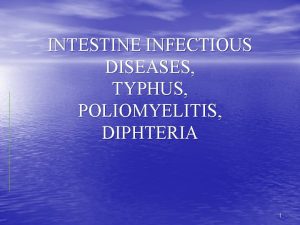Epidemiology of Poliomyelitis 24 09 2020 1 Contents




























- Slides: 28

Epidemiology of Poliomyelitis 24 -09 -2020 1

Contents Slide No. Introduction Magnitude of problem 3 3 World Scenario SEAR Scenario Nepal Scenario 4 9 15 Epidemiology Agent factors Host factors Environment factors Incubation period Mode of transmission Clinical features Laboratory diagnosis Complication 24 -09 -2020 Treatment Prevention and control Polio eradication effort References 20 20 21 21 22 24 24 24 25 26 34 2

Introduction Poliomyelitis is an acute viral infection caused by Polio virus (RNA virus) which is primarily an infection of alimentary tract but may infect the central nervous system in a very small percentage of cases resulting in varying degrees of paralysis and possibly death. Magnitude of problem ØMany Developed Countries got rid of Poliomyelitis ØIt is still existing as a problem in Eastern. Mediterranean, Africa and South East Asia. ØIn Nepal, it is occurring Sporadically. ØIn Nepal, 6 (all WPV 1)cases have appeared till now in 2010 24 -09 -2020 3

World Trend of AFP, Polio cases *Data as of 19 th-Nov-2010 Year Total AFP cases Reported Total Confirmed Polio cases 2004 2005 2006 2007 42505 62434 68519 77392 1257 2029 2020 1387 2008 2009 2010 85404 90227 81338 1732 1103 830 24 -09 -2020 Total Confirmed Wild Polio cases 1255 1979 1997 1315 1651 1604 789 4

24 -09 -2020 5

24 -09 -2020 6

24 -09 -2020 7

24 -09 -2020 8

SAARC Trend of AFP, Polio cases *Data as of 19 th -Nov-2010 Year Total AFP cases Reported 2004 16270 134 2005 31530 419 373 2006 36665 702 701 2007 46124 890 2008 50509 565 2009 54962 756 741 2010 50901 48 46 24 -09 -2020 Total Confirmed Polio Cases Total Confirmed Wild Polio Cases * Out of 48 cases in SEAR in 2010, 42 cases from India and 6 cases from Nepal 9

24 -09 -2020 10

Nepal Trend of AFP, Polio cases *Data as of 19 th-Nov-2010 Total AFP cases Reported Total Confirmed Polio cases 2004 214 0 0 2005 230 4 4 2006 364 5 5 2007 343 5 5 2008 425 6 6 2009 452 0 0 2010 537 6 6 Year 24 -09 -2020 Total Confirmed Wild Polio cases 11

Acute Flaccid Paralysis (AFP) Cases, Nepal, 2010 AFP cases = 471 Wild Polio cases= 6 District with AFP cases = 68 Data as of 01 Oct 2010 24 -09 -2020 WHO-IPD 12

Epidemiology Agent Factors Causative Agent: Polio virus Type 1, 2 & 3 (More commonly type 1 causes paralytic Polio) Reservoir: Human being Source of infection: Oropharyngeal secretion, faece Period of communicability: 24 -09 -2020 7 -10 days before and after onset of symptoms 13

Host factors: Age: - Mainly 6 months to 3 years age group Sex: - Male: Female 3: 1 Immunity: - Immunity for only that type after attack Risk factors: -Fatigue, trauma, IM injections, tonsillectomy, precipitate an attack of polio Environment factors: Ø Poor waste Management Ø Rainy season Ø Overcrowding Ø contaminated water, food and fly Incubation period: 7 -14 days Mode of transmission Ø Faeco-oral transmission 24 -09 -2020 Ø Droplet Infection 14

Clinical Features 4 types of Polio 1. Inapparrent (subclinical) Infection Ø 95% cases are without signs and symptom Ø Detected only by laboratory test 2. Abortive polio or Minor Illness Ø Occurs among about 4 -8%casses, Ø Appearance of general signs and symptoms like fever, headache, weakness Ø Signs and symptoms disappear in few days 3. Non Paralytic Polio Ø Occurs among about 1% cases, Ø Appearance of Pain and stiffness on neck and back of body Ø Signs and symptoms disappear in 2 -10 days 24 -09 -2020 15

4. Paralytic Polio Ø Ø Ø Ø Occurs among less than 1% cases Virus invades CNS and causes paralysis Asymmetrical flaccid paralysis Pain and stiffness on neck and back muscle Tripod sign may be present Kerning’s sign positive If respiratory muscle paralysis, respiratory failure and may be death Ø If cranial nerve affected, ü ü ü 24 -09 -2020 Diplopia Dysphasia Facial muscle weakness 16

Laboratory diagnosis: Virus isolation from faecal and oropharyngeal specimen Complication: - Paralysis Treatment ØNo specific Treatment: ØGood nursing care ØIf respiratory distress, artificial respiration ØIf paralysis, physiotherapy ØReferral to hospital 24 -09 -2020 17

Prevention and control 1. Immunization Ø Routine Immunization: -Sabin Polio Vaccine 2 -3 drop orally ; 3 doses at 6, 10 and 14 weeks of age(consecutive doses a least 1 month apart) Ø Supplementary Immunization: - Sabin Polio Vaccine Oral Immunization of 0 -5 years of children in NID, SNID and mopping -Up immunization programmes 2. Proper disposal of faece, sputum, saliva etc. of patients 3. Immediate referral of suspected AFP cases to Hospital or IPD center 4. Regular surveillance 5. Health education 24 -09 -2020 18

Polio eradication effort Ø In pre-vaccination era, Polio was found all the world Ø Extensive use of Polio vaccine since 1954 has eliminated Polio in developed countries Ø In 1988, world health resolved to eradicate polio globally Ø Nepal is one of the signatories of the polio eradication initiative and Polio Eradication is a priority program of Government of Nepal 24 -09 -2020 19

Contd… Ø Nepal is conducting NIDs since FY 2053/54 Ø In 2061/62(2005 Technical Consultative Group (TCG) recommended that Nepal need not to continue with NID Ø Nepal didn't conduct NIDs in 2061/62 (2005) and 2062/63 Ø Besides NID, Nepal has been conducting mop up activities in response to each detected wild polio cases 24 -09 -2020 20

Progress to Polio eradication in Nepal Ø Nepal didn’t detect any Poliomyelitis case due to wild virus from 2001 till 2004 Ø In 2005, 4 cases were detected in Sarlahi and Rautahat district Ø Then onwards, Polio cases have been detected sporadically 24 -09 -2020 21

Polio is eradicable because ØMan is the only host ØHalf life of excreted virus in sewage is only 24 hours spread occur only during this period ØA long term carrier state is not known to occur ØAvailability of an easy and effective intervention i. e. Oral Polio vaccine ØDiagnostic tools with sufficient reactivity and specificity to detect level of infection 24 -09 -2020 22

Basic strategies for eradicating polio 1. Immunization a. Routine immunization: - Sabin Polio Vaccine 2 -3 drop orally ; 3 doses at 6, 10 and 14 weeks of age (consecutive doses one month apart) b. Supplementary immunization i. National immunization days(NIDs): ØImmunization campions all over the country on the same date 24 -09 -2020 ØAll 0 -5 years children receive 2 extra dose of OPV on 2 days separated by 4 -6 weeks irrespective of previous immunization 23

Contd…… ii. Sub- National immunization days(NIDs): Immunization of All 0 -5 years children with same and same schedule in high risk districts dose c. Mopping-Up ØLast stage in polio eradication ØDoor to door immunization in high risk districts where wild polio virus is suspected to exist 2. Surveillance of Acute Flaccid Paralysis(AFP) ØTo know polio endemic zone ØTo know target population to give vaccine ØTo identify all reservoir of wild polio transmission 24 -09 -2020 24

Polio Epidemic: Appearance of 2 or more local cases caused by same type of virus within 4 weeks period is known as Polio Epidemic. 24 -09 -2020 25

References 1. Park. K, Textbook of Preventive and social Medicine. 18 th edition, Banarasidas Bhanot Publishers, Jabalpur-India 2. K. C. Saroj, Applied Epidemiology in Nepalese Context; A. K. Books & Educational Enteprises, Nepal 2007 3. Annual Report; Department of Health Services, 2005/6 - 2008/9 4. Class-notes 5. http: //www. who. int 6. www. searo. who. int 24 -09 -2020 26

Feedback and Suggestion are welcome 24 -09 -2020 27

Thank you 24 -09 -2020 28
 Prevention and control of poliomyelitis
Prevention and control of poliomyelitis Tripod sign in polio
Tripod sign in polio Blastomycosis
Blastomycosis Prevention and control of poliomyelitis
Prevention and control of poliomyelitis Types of poliomyelitis
Types of poliomyelitis Synoviitis
Synoviitis Primary prevention of poliomyelitis
Primary prevention of poliomyelitis Seven uses of epidemiology
Seven uses of epidemiology Secondary attack rate formula
Secondary attack rate formula Thesourceagents
Thesourceagents Distribution in epidemiology
Distribution in epidemiology What is descriptive study in epidemiology
What is descriptive study in epidemiology Recall bias
Recall bias How dr. wafaa elsadr epidemiology professor
How dr. wafaa elsadr epidemiology professor Cbic recertification
Cbic recertification Prevalence calculation
Prevalence calculation Diabetic ketoacidosis epidemiology
Diabetic ketoacidosis epidemiology Prevalence defination
Prevalence defination Difference between descriptive and analytical epidemiology
Difference between descriptive and analytical epidemiology Epidemiological triad
Epidemiological triad How dr. wafaa elsadr epidemiology professor
How dr. wafaa elsadr epidemiology professor Epidemiology person place time
Epidemiology person place time Ramboman
Ramboman Spurious association
Spurious association Measures of association in epidemiology
Measures of association in epidemiology Attack rate epidemiology formula
Attack rate epidemiology formula Nutritional epidemiology
Nutritional epidemiology Ecological study design
Ecological study design Distribution in epidemiology
Distribution in epidemiology
